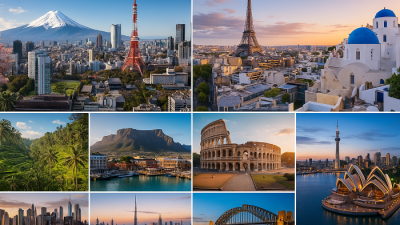Sustainable travel has become more than just a passing trend, it is a conscious movement reshaping the way we explore the world. Travelers today are increasingly aware of their environmental footprint, seeking destinations that prioritize conservation, green living, and community support. Eco-friendly travel destinations not only provide breathtaking landscapes and unique experiences but also allow visitors to contribute positively to the environment and local communities. Whether it is reducing carbon emissions, supporting wildlife protection, or staying in sustainable accommodations, eco-tourism offers travelers a chance to enjoy meaningful journeys while preserving the planet.
In this article, we explore the top 10 eco-friendly travel destinations around the world that set the benchmark for responsible tourism. Each of these places combines natural beauty with a commitment to sustainability, making them perfect for travelers who want to explore guilt-free.
1. Costa Rica – The Global Leader in Eco-Tourism
Costa Rica has long been considered a pioneer in sustainable travel. Nearly 25 percent of its land is protected through national parks and reserves, offering lush rainforests, volcanic landscapes, and rich biodiversity. Visitors can experience eco-lodges powered by renewable energy, participate in wildlife conservation programs, and enjoy nature-based activities like ziplining, birdwatching, and hiking. Costa Rica’s dedication to renewable energy and its ambitious goal of becoming carbon neutral make it a must-visit destination for eco-conscious travelers.
2. Bhutan – The Carbon-Negative Kingdom
Nestled in the Himalayas, Bhutan is the only carbon-negative country in the world, meaning it absorbs more carbon dioxide than it emits. Guided by the principle of Gross National Happiness, Bhutan limits mass tourism to protect its culture and environment. Visitors can enjoy pristine landscapes, trekking routes, and ancient monasteries while supporting a nation deeply committed to conservation. The country’s strict environmental policies, including bans on plastic bags and sustainable farming practices, make Bhutan a shining example of eco-friendly tourism.
3. New Zealand – Adventure with a Green Heart
New Zealand is famous for its dramatic landscapes, but it also leads in sustainable tourism initiatives. The Tiaki Promise encourages visitors to respect the environment and leave no trace while traveling. From geothermal parks to fjords, New Zealand offers a wide range of eco-adventures such as kayaking, cycling trails, and wildlife spotting. Eco-lodges and sustainable tour operators are widely available, making it easy for travelers to align their adventures with green values.
4. Iceland – Powered by Nature
Iceland is a land of glaciers, geysers, and volcanoes, powered almost entirely by renewable energy sources like geothermal and hydropower. Travelers can soak in natural hot springs, hike across lava fields, and admire the Northern Lights while minimizing their environmental impact. The country places strong emphasis on eco-friendly accommodations and responsible tourism practices, ensuring that its fragile ecosystems remain preserved for future generations.
5. Slovenia – Europe’s Green Gem
Slovenia has earned recognition as one of the most sustainable countries in Europe. Its capital, Ljubljana, was awarded the title of European Green Capital thanks to its pedestrian-friendly zones, cycling infrastructure, and commitment to zero-waste initiatives. Travelers can explore eco-villages, enjoy organic farm-to-table cuisine, and hike through the pristine landscapes of Triglav National Park. Slovenia seamlessly combines cultural heritage with sustainability, making it ideal for eco-conscious travelers seeking authentic European experiences.
6. Kenya – Wildlife Conservation at its Core
Kenya is world-renowned for its wildlife safaris, but beyond its iconic game reserves lies a strong dedication to eco-tourism. Community-led conservancies ensure that tourism supports local livelihoods while protecting endangered species. Many lodges in Kenya use solar power, limit water usage, and support reforestation projects. Travelers can experience the thrill of spotting elephants, lions, and rhinos while contributing directly to conservation and community empowerment.
7. Norway – A Model of Green Innovation
Norway combines natural beauty with forward-thinking sustainability policies. Known for its fjords, glaciers, and the midnight sun, the country promotes eco-friendly travel through electric ferries, scenic railways, and sustainable fishing practices. Oslo, the capital, was named the European Green Capital for its dedication to cutting carbon emissions and promoting green urban living. Whether cruising the fjords or exploring Arctic landscapes, Norway provides eco-friendly travel at its finest.
8. Ecuador – Gateway to the Galápagos Islands
Ecuador is a dream destination for eco-travelers, particularly those interested in the Galápagos Islands. The government enforces strict conservation policies to protect the islands’ fragile ecosystems and unique wildlife. On the mainland, Ecuador also promotes eco-tourism through sustainable lodges in the Amazon rainforest and Andean highlands. By supporting eco-certified tours, travelers can enjoy Ecuador’s biodiversity while ensuring that their visits help fund conservation efforts.
9. Finland – The Land of Clean Air and Forests
Finland consistently ranks as one of the world’s cleanest and greenest countries. With over 75 percent of its land covered by forests, the country emphasizes sustainable forestry and eco-tourism practices. Visitors can enjoy activities like foraging, wild swimming, and staying in eco-cabins designed to blend with nature. Finland’s commitment to sustainable food, renewable energy, and responsible travel experiences makes it a top choice for eco-minded adventurers.
10. Palau – A Small Island Making a Big Impact
Palau, a small island nation in the Pacific Ocean, has become a global leader in marine conservation. The Palau Pledge requires all visitors to sign an environmental commitment upon entry, ensuring respect for its reefs and ecosystems. The country has established one of the largest marine sanctuaries in the world, protecting fish, corals, and marine life from destructive practices. Palau proves that even small destinations can set powerful examples for sustainable tourism.
Why Eco-Friendly Destinations Matter
Choosing eco-friendly travel destinations ensures that our wanderlust does not come at the expense of the planet. By supporting countries and communities that prioritize sustainability, travelers help reduce carbon emissions, protect endangered wildlife, and preserve cultural heritage. These destinations demonstrate that responsible tourism can go hand in hand with unforgettable experiences, creating a win-win for both travelers and the environment.
Conclusion
The future of travel lies in sustainability, and the destinations listed above are leading the way in redefining how we explore the world. From Costa Rica’s lush rainforests to Palau’s pristine marine reserves, each of these places offers travelers the chance to experience beauty, adventure, and culture without leaving a heavy footprint behind. As more travelers embrace eco-friendly journeys, these destinations prove that protecting the planet can be both rewarding and inspiring.
Frequently Asked Questions on Eco-Friendly Travel Destinations
Q1. What makes a travel destination eco-friendly
Answer. A destination is eco-friendly when it prioritizes sustainable practices such as renewable energy, wildlife conservation, waste reduction, and community-focused tourism.
Q2. How can travelers reduce their carbon footprint while traveling
Answer. Travelers can choose direct flights, use public transport, stay in eco-certified accommodations, and support local businesses to minimize environmental impact.
Q3. Which eco-friendly destination is best for wildlife enthusiasts
Answer. Kenya and Ecuador are top choices, offering opportunities to see iconic wildlife in safaris and the Galápagos Islands under strict conservation policies.
Q4. Are eco-friendly destinations more expensive
Answer. Not necessarily. While some eco-lodges may cost more, many eco-friendly destinations offer budget-friendly sustainable options like community homestays and eco-hostels.
Q5. How can I ensure my travel supports local communities
Answer. By booking with local tour operators, dining at family-owned restaurants, and buying locally made products, travelers directly contribute to community development.



